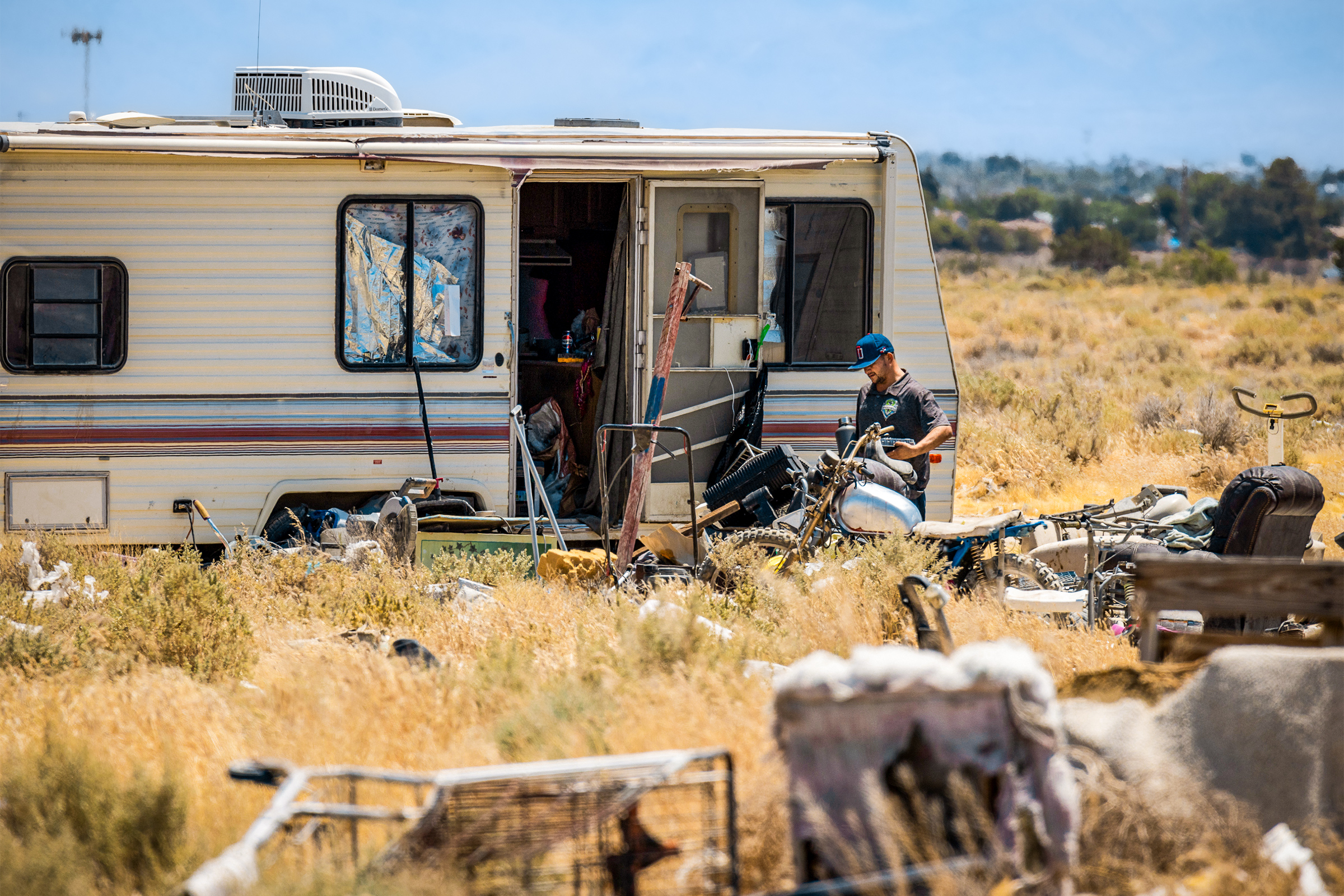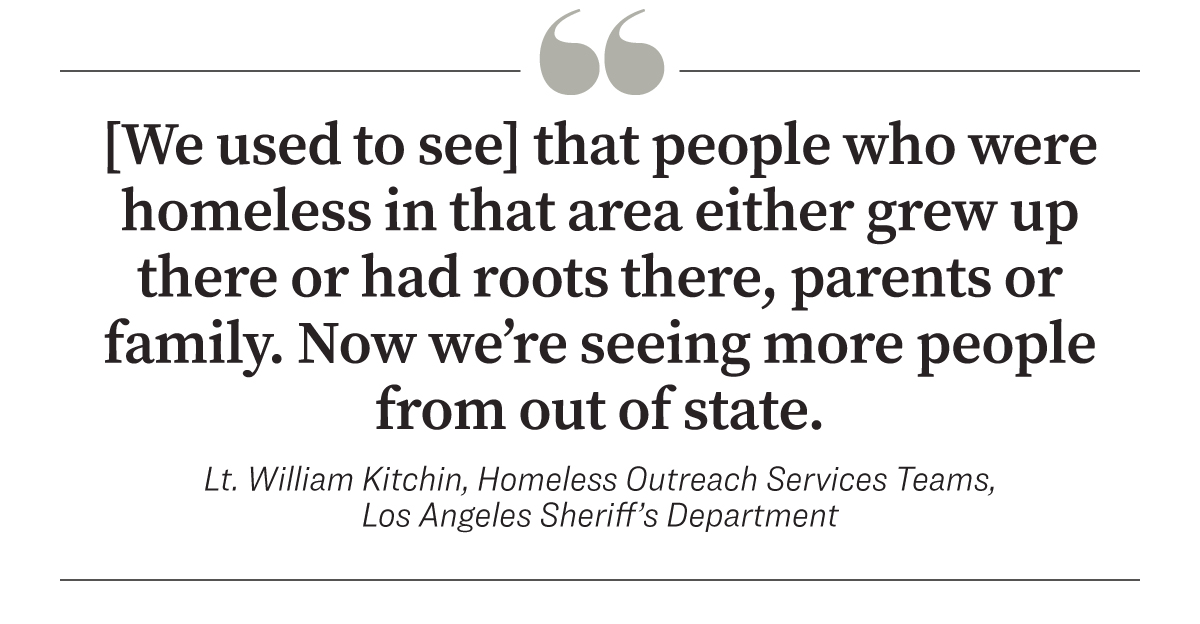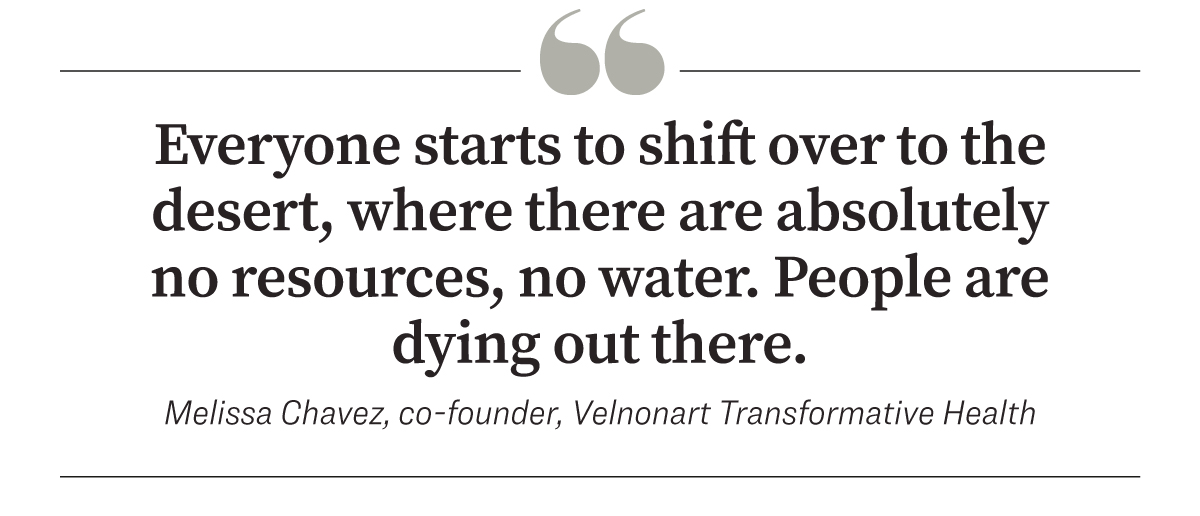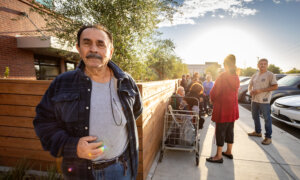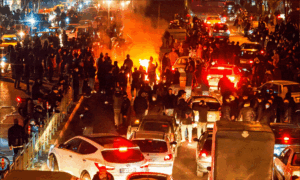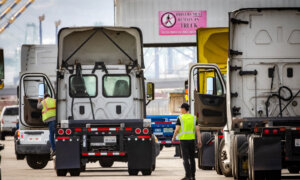LOS ANGELES—In the scrubby Mojave desert north of Los Angeles, a sprawling encampment of decrepit RVs sits just off a dirt road separating the city of Lancaster from Los Angeles County’s unincorporated expanse.
In every direction, garbage spreads out like an algae super bloom—beyond that, endless sand and brush, baking in the summer sun.
“Keep your head on a swivel for dogs,” a member of the city’s public safety and emergency response unit tells us. Through the haze, we see two pit bulls and a German Shepherd under a tarp, but they are tethered, too hot to move.
Freddy, a resident, seems only moderately bothered by the 110 degree temperature.
“I don’t have a car anymore, so I can’t get my own water,” he says when asked how he survives out here.
“Someone brings me water every two weeks,” he said, referring to a nonprofit.
Pointing down at his legs, scaly and engorged beneath black shorts, he adds: “And I’m sick, too. They bring me medicine.”
There is no grid here, no power or water. RV residents dump their raw sewage in the desert, either right outside their vehicles or sometimes with a hose that carries it a little farther out.
Such encampments, which are also a magnet for illegal construction dumping, appear as clusters on satellite maps, dotting the rugged terrain just past the county line. Officials say they stretch out as far as 10 miles into the desert, but most stay closer to town.
Freddy is one of thousands without housing in the northern part of the county, according to data released last month by the Los Angeles Homelessness Services Authority (LAHSA).
On any given night, an estimated 6,672 people are homeless in the Antelope Valley—a 42 percent increase over the year prior. But only 1,057 of the region’s homeless people live in its two main cities, Lancaster and Palmdale, leaving the remaining 5,615 in smaller towns and the region’s rural unincorporated areas.
It’s surprising that so many people could be living in tents, under tarps, and inside of old RVs out in the middle of the high desert with no water or infrastructure.
But those familiar with the situation say the population was already high, and the dramatic jump simply represents a more thorough count this year.
“The count went up this year because the count was done wrong in previous years,” a city official, who asked not to be identified by name, said. “This year we utilized a drone, and our teams went out to remote areas and did the count.”
He estimated that the actual increase over past year might be closer to 25 percent.
L.A. County Supervisor Kathryn Barger, whose Fifth District includes the Antelope Valley, also suggested that the increase may not be as straightforward as it looks.
“The Point In Time Count is not a perfect science and it’s rightfully evolving,” she said in an email to The Epoch Times, expressing uncertainty over whether the number reflects an increase or a better count.
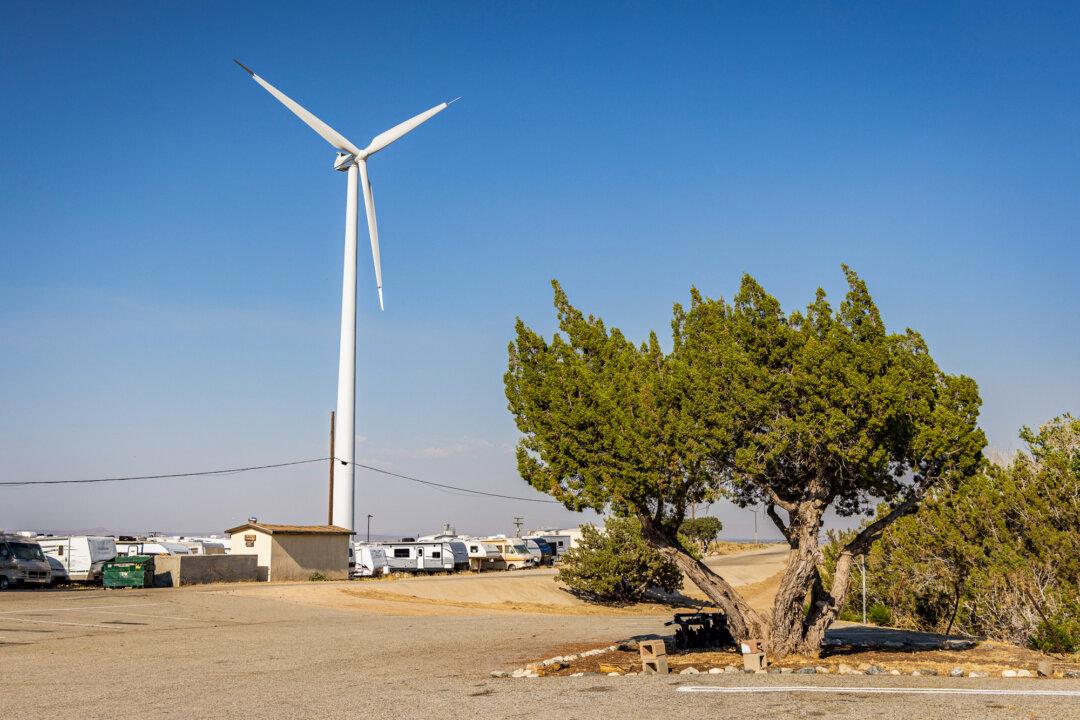
A wind turbine system outside of Palmdale, Calif., on July 10, 2024. Palmdale’s homeless count rose from 177 in 2023 to 537 in 2024. (John Fredricks/The Epoch Times)
“Regardless, we will use those results to draw down more federal and state funding so that we can deliver more local housing and shelter options. The need in the region is real.”
Either way, the uptick is an outlier in 2024, when the county overall and most city homeless populations are either remaining stable or shrinking slightly.
The City of Lancaster’s overall homeless count went down in 2024, to 520 people from 590 the year prior, with fewer unsheltered homeless and more sheltered homeless individuals. Palmdale’s, meanwhile, rose to 537 from 177.
Inquiries to Palmdale city officials, including the mayor and city councilmembers, were not returned.
LAHSA also did not respond to a request for comment on the increase in the homeless population in Antelope Valley.
While many municipalities across the West stopped clearing homeless encampments after a series of Ninth Circuit Court decisions determined that anti-camping laws violated the Eighth Amendment, Lancaster bypassed those restrictions with procedural caveats, by offering shelter before moving people.
Since the Supreme Court reversed the lower court rulings earlier this month, officials say, enforcement is easier.
Critics of such enforcement, such as the ACLU, have long argued that Lancaster is pushing people who have nowhere to go into dangerous, extreme conditions. But officials say there are beds available, and enforcement is attended by offers of services and shelter.
So why are thousands of people homeless in the desert?
End of the Line
Lancaster Mayor Rex Parris, an outspoken critic of what he says is the county’s neglect of the region, allows that there are various factors that might contribute to an increase in homelessness—including former inmates at California State Prison, in Lancaster, who end up in the community without services, along with a small percentage of people losing housing or falling on hard times.

Lancaster has always been a far more affordable bedroom community, but median rent is currently $2,595 a month—only about $200 cheaper than Los Angeles, according to real estate website Zillow.
But the main reason, Mr. Parris told The Epoch Times, is L.A.’s systematic tendency—not a conspiracy, exactly, more like a default setting—to send its problems north.
“I think it’s tied to the L.A. area pushing them up here,” he said of the homeless count increase. “They tend to push all of their problems up here, if they can. And now you’ve got the World Cup, and you’ve got the Olympics coming, and they’re in a mad rush to get rid of their homeless, and so they encourage them to come here.”
Mr. Parris says his teams are “constantly interviewing people who were given a ticket and told, ‘go to Lancaster,’” but did not specify by whom.
“It’s at the end of the Metro line, literally,“ he said. ”This is not unusual.”
The county’s transit system, plagued by violence in recent months, has its own problems. Used as a de facto shelter by thousands during the day, its buses and trains are emptied for cleaning each night, which some end-of-line cities say has resulted in sharp increases in their transient homeless populations.
Lancaster, 60 miles north of Los Angeles and at the very end of the Metro transit system, is far more remote than other such cities.
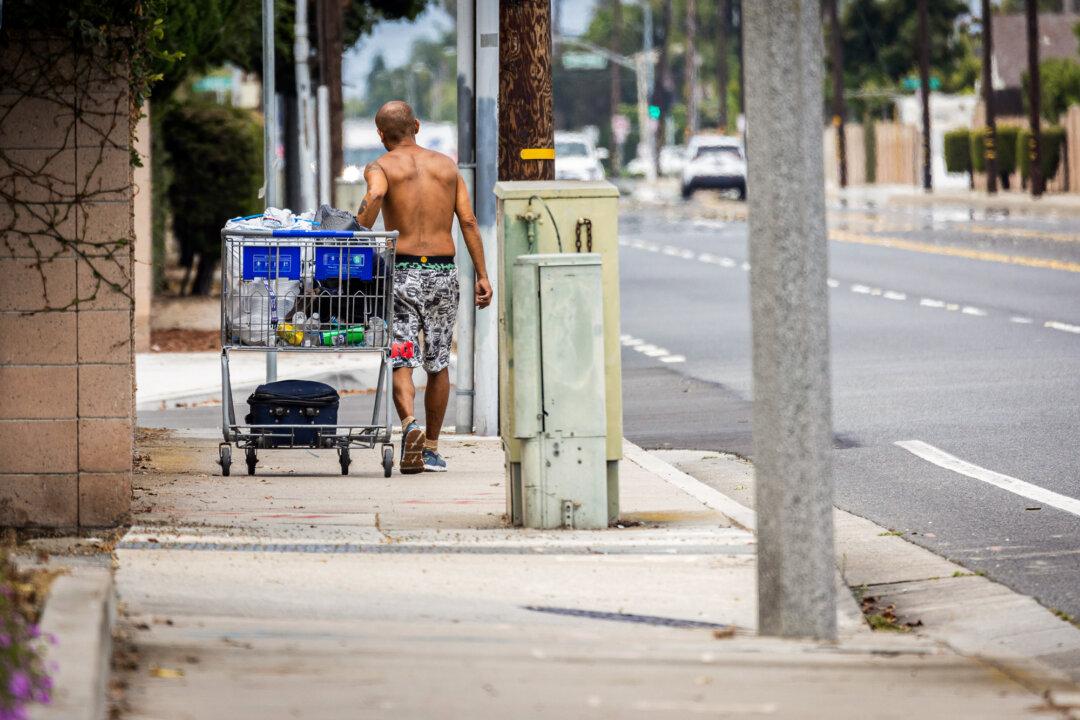

(Top) A homeless man walks with his belongings along a street in Santa Ana, Calif., on July 15, 2024. (Bottom) A homeless individual rests by a busy street in Santa Ana, Calif., on July 15, 2024. (John Fredricks/The Epoch Times)
Lt. William Kitchin, who oversees the Los Angeles Sheriff’s Department’s (LASD’s) homeless outreach team for the entire county, said he has not personally seen evidence to support the idea that people are being directed to the region but has observed migration to end-of-line cities.
However they end up there, once in Lancaster, civil rights groups say, authorities have routinely pushed homeless people out into the desert.
In a study based on interviews with 53 unhoused people in and around Lancaster from February 2019 to October 2020, the ACLU claimed that the LASD “banished” people to remote county areas, combining the threat of criminal and civil sanctions with “suggestions” to leave town.
Such claims, the lieutenant said, are easily disproved by body cameras that record deputies’ interactions when enforcing local ordinances.
Lt. Kitchin’s team works with LAHSA to resolve encampments of more than five people, and he said such operations are always done with advance notice and offers of services and housing.
“We can’t dictate or tell people where to go. We just say you can’t be here. We prefer you take the services that were provided, so you can go inside and get your life started on the right track, but we can’t force them into it,” he said.
Starting on July 22, his team plans to clear desert encampments in an area north of Lancaster and place an estimated 40 people in hotels as part of the county’s “Pathway Home” program.
“Prior to the pandemic,” the lieutenant said, “what we used to see is that people who were homeless in that area either grew up there or had roots there, parents or family. Now we’re seeing more people from out of state.”
Officials who asked not to be identified by name said they see a constant influx of new faces in Lancaster and the surrounding area.
“We know everyone here, and every day we’re seeing new people,“ one said. ”It’s not people losing their homes, there’s some of that, but mostly it’s not. They came from somewhere else, they moved here.”
The city’s team has access to five beds for immediate shelter. After two weeks, they move people to Kensington, Lancaster’s sprawling homeless housing campus—so those five beds always stay open for people who might need them, officials said.
Mayor Parris told The Epoch Times that beds remain open at Kensington throughout the year, except when extreme weather drives occupancy up.
Opened in 2019, the campus has 153 interim beds and 150 permanent supportive housing beds, and it receives more referrals than it has availability, a representative for A People Concern, the organization that operates the campus, told The Epoch Times in an email.
The representative said they are currently “nearing capacity,” with a “fluctuating occupancy as individuals may choose to transition between programs.”
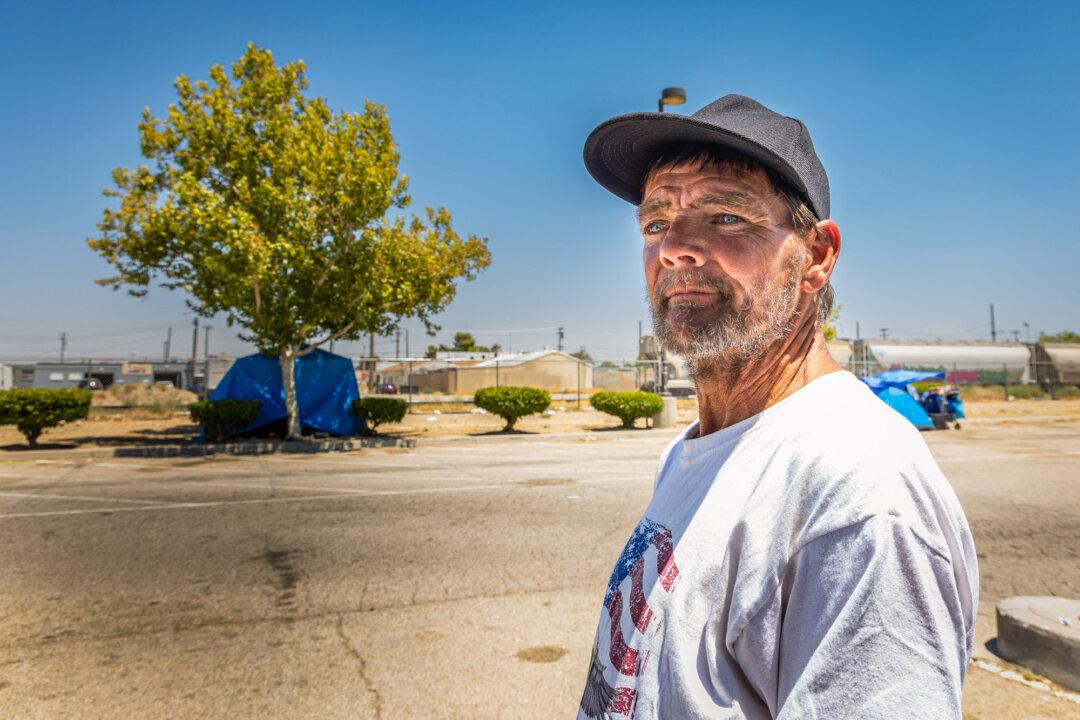
Michael, a homeless man, passes by an area with tents housing the homeless, near Lancaster, Calif., on July 10, 2024. (John Fredricks/The Epoch Times)
Mr. Parris draws a hard line between what he characterizes as a minority of the homeless population in his city, who have fallen on hard times or been pushed out of housing—and an overwhelming majority, who refuse housing and choose the streets and drug abuse as a lifestyle.
“I was a drug addict, and I have been homeless. And I have been in jail,” Mr. Parris, a lawyer, said. “So none of this is foreign to me. You know, I think I probably have a better understanding of it than most. But I know the difference between a looter and someone who needs help—and wants help.”
“We have the most state-of-the-art homeless shelter in the entire county—and we did it for about a third of the cost they spend in L.A.,“ he said. ”And we have beds available for people who want them. But that means you’ve got to follow some rules—not a lot of rules, but some rules. And so beds go empty, except for when the heat is extraordinarily high, like it is now, or when it’s really cold.”
Like all publicly funded homeless programs and facilities in California, where “housing first” and “harm reduction” policies are written into the law, Kensington cannot require sobriety or treatment as a pre-condition or condition of housing.
“It’s challenging, a lot of what we see is either substance abuse or mental illness or combination of both,” Lt. Kitchin said. “So we’re trying to create that balance ... of giving people respect and dignity.”
But, he added, “they’re not going to be allowed to stay if they don’t accept [housing offers].”
Many people living on the streets do not want to go to congregant shelters, for a variety of reasons, ranging from previous trauma to a dislike of the structure or rules.
Hotel rooms, like those offered as part of Pathway Home, are often a more attractive option, and more costly.
“I’d love to have a beach house in Malibu,” Lt. Kitchin said. “Some people don’t like congregate shelter, but if it’s offered they need to realize it’s a step, it’s progress, out of the elements.”
Shelter Space
In a large parking lot beside the Metro system’s final stop and across from the LASD Lancaster Station, small clusters of tents line the shady edges. Authorities moved people out and cleared away the garbage about a week prior, but some have returned.
Squalid piles of rotting trash, tents, broken furniture, stained mattresses, and boxes filled with rapidly spoiling food make up a micro village. Ron, a middle-aged man reclining in a low-slung chair, says outreach workers do “come around” to help people with housing, “but there’s a lot of hoops you have to jump through.”
“And no one wants to go to that shelter on 60th Street,” he said, referring to a LAHSA congregant shelter that serves three meals and welcomes pets.
“It’s dark, it’s gloomy ... the lighting sucks. You see people walking around listlessly,” he said. “The place itself is depressing.”

A homeless person walks barefoot in 107 degree Fahrenheit heat near Lancaster, Calif., on July 10, 2024. (John Fredricks/The Epoch Times)
That facility is part of the Glenchur Interim Housing Project, a $1.4 million remodel of a former medical facility. The first phase was completed in December 2023, expanding a former seasonal shelter to a year-round program in April, while a second phase, expected to wrap up by early August, will add more beds.
A spokesperson for Volunteers of America Los Angeles, the nonprofit that runs the shelter, said they currently have 139 beds that are at capacity for referrals but said cots are added as needed if people show up, and they are “not having to turn anyone away.” A spokesperson for LAHSA said in an email that the shelter has a total of 162 beds and that it is at capacity.
Volunteers of America Los Angeles, which received $55 million in federal funding in 2024, last year received a $359,750 grant from the county to operate the Lancaster shelter.
Asked whether he feels safe in the Metro parking lot, Ron, the man living in the encampment, said: “Hell no ... We spend most of the evening awake.”
“They walk up and down here; it’s relentless,” he said, referring to theft and assault by people high on meth. “I call them the walking dead.”
A few yards away, a minivan belonging to a local nonprofit was passing out care packages—basic toiletries and sunblock, as well as other harm reduction staples such as syringes, in paper bags.
Melissa Chavez, co-founder of Velnonart Transformative Health, which provides street medicine, treatment for substance abuse disorder, and case management, says the challenge is keeping track of people—and coordinating with housing agencies.
“In this area there’s a huge scarcity of service providers. One of the biggest issues is these folks are constantly moving,” she told The Epoch Times, making follow-up “almost impossible.”
As the government enforces camping bans, she said, “everyone starts to shift over to the desert, where there are absolutely no resources, no water.”
“People are dying out there,” she said. “I’ve had to call the paramedics a few times.”
Velnonart receives private grants and contracts with the county to provide substance abuse prevention and control services. In 2024, it received a $346,800 grant from the California Department of Healthcare Services, partly funded by the state’s legal settlements with opioid manufacturers.
Ms. Chavez says mandating treatment for substance abuse and mental health doesn’t work, that the process requires trust-building and patience. But even if people decide they are ready, it’s difficult to connect with treatment centers and housing providers.
Asked whether she tries to find shelter for people on the streets, she said: “We do. The problem is there’s really no response in return.”
The same goes for treatment centers.
“After a few times of us sending our patients, they don’t take our calls anymore,” she said. “I can’t get a treatment center to partner with us.”

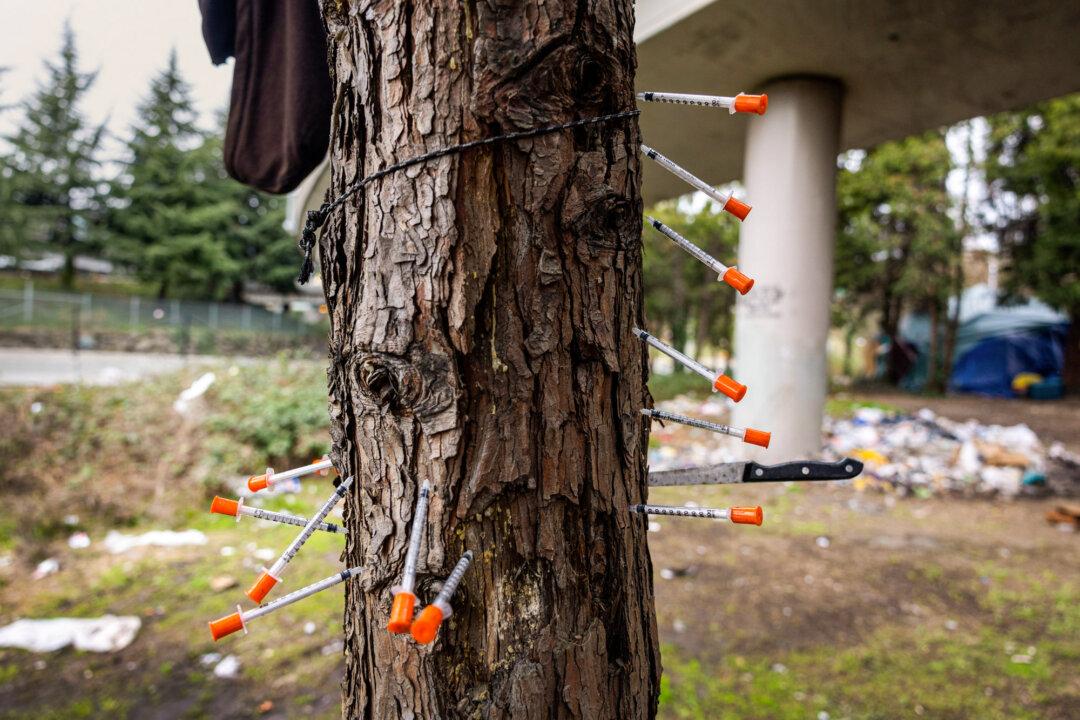
(Top) A pipe used for drugs lays near a homeless encampment in Lancaster, Calif., on July 10, 2024. (Bottom) Used heroin syringes are stuck in a tree at a homeless encampment in Seattle on March 13, 2022. (John Fredricks/The Epoch Times, John Moore/Getty Images)
Crisis of Extremes
The crisis of homelessness in the Antelope Valley takes place in a context of extremes. In winter, temperatures can reach 2 F, and in the summer 115 F, making shelter a more urgent concern. The area is removed from the metropole by a mountain and is in many ways already beleaguered, with high burdens on existing infrastructure.
In 2022, the region had by far the highest rate of fentanyl overdose emergency room visits—more than double that of the next highest region—and from 2016 through 2023, the third-highest fentanyl overdose death rate in the county. In 2019, it had the lowest life expectancy and highest mortality rates.
The Valley is also home to a convergence of volatile forces from the surrounding areas, including organized crime.
“We had a gang war break out in the middle of the city,” Mr. Parris said, referring to a series of 10 shootings in 48 hours last month that left several people dead. “They were using high-power assault weapons. And our sheriffs were powerless, because we’re usually running at about 50 percent less than what we need.”
According to LASD data, the first five months of 2024 have seen Part 1 crimes—such as homicide, arson, and theft—increase by only 3.53 percent in the area. But unincorporated areas had a 150 percent increase in rape, a 180 percent increase in robbery, and an overall increase of 33 percent in violent crimes in the same period.
The Lancaster Sheriff’s Station, among the busiest in the county, patrols a 600-square-mile area that includes 159,000 residents and several thousand more in unincorporated areas. Amid a staffing crisis, it uses overtime to fill contractual obligations to the city, which Mr. Parris said requires deputies to regularly work 16- to 18-hour shifts.

One deputy, who declined to be identified by name, told The Epoch Times there are typically no more than a dozen deputies on duty any given day, and fewer at night; he once worked 37 days without a break.
“We’re forgotten about. That’s why they ship everybody out here,” he said.
The city recently created its own Lancaster Police Department, but its first sworn officers have yet to be recruited. According to the mayor, it will primarily assist with technology.
“We’re putting cameras everywhere. We’ve got a drone program where we can launch them in 60 seconds,” Mr. Parris said. “I don’t like living that way ... but what alternative do we have?”
In March, Lancaster sued the LASD for overcharging it and dozens of other cities it contracts with for policing services. When L.A. Sheriff Robert Luna announced a “surge” of resources following the June shootings, the mayor thanked him but said it would not deter legal action to ensure Lancaster has the public safety resources it pays for and is “entitled to.”

Los Angeles Sheriffs Department deputies work in Lancaster, Calif., on July 10, 2024. (John Fredricks/The Epoch Times)
However, funding is only part of the problem. Law enforcement agencies across the country are struggling to recruit. Anti-police sentiment following the death of George Floyd, early retirements, and a waning interest in the profession have decimated staffing. Despite funding increases, as of January, the LASD has more than 1,200 sworn vacancies.
In Antelope Valley, aside from a few who are from the area and care about its future, “no one wants to stay ... because it’s so dangerous,” a law enforcement official said.
“It’s not worth it. They all leave,” he said.
Encampment Living
Along the banks of Amargosa Creek, just off State Route 14 in Lancaster, sections of the dry bed are scorched carbon-black from encampment fires. Sections of the fence have been scrapped for metal, and trash is strewn in every direction—a half-filled job application flutters next to a greasy rotisserie chicken bag, shattered smartphones, suitcases, wheelchairs, cosmetics, and electronics, the sundry signs of developed-world homelessness.
“We’ve cleaned up more than 100 tons of trash so far this year. It’s like whack-a-mole, nonstop. There’s so much trash we can’t keep up with it,” a city worker told The Epoch Times.
From the other side, a woman in a pink skirt steps gingerly through an encampment and down the embankment. She is barefoot, picking her way across the burning sand. A public safety team member chats with her and tosses over a bottle of water.
He points to a burned out, condemned motel across the highway where they say she lives, and where she is being prostituted. Law enforcement has gone in with warrants and shut the place down—inside they found a “kingpin” and the women he prostituted, mothers with small children, and people still paying for their rooms with government vouchers.
The city boarded it up, but people ripped off the boards and climbed back in.
“Most of our homeless population are criminals,” a city worker said plainly.
Outreach workers say they notice an uptick in crime with the heat, which also exacerbates drug-induced psychosis among unsheltered residents.
“They’re strung out on meth and it’s 110 degrees,” one said, exasperated.
While more attention has been given to mental health and substance abuse treatment as California confronts its escalating homeless crisis, efforts to mandate treatment or expand conservation are met with stiff political resistance.
Meanwhile, effective decriminalization of hard drug possession means that people suffering from addiction—especially in the age of fentanyl and “super meth”—can remain addicted on the streets, without interruption.
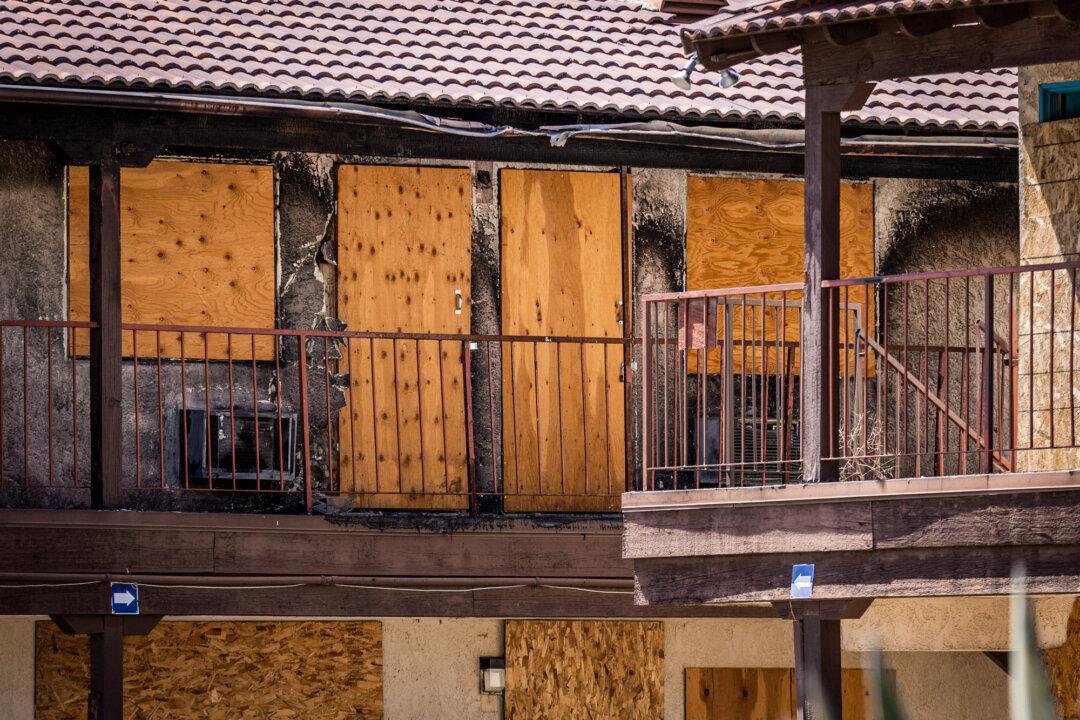
Homeless people live in the abandoned Lancaster Inn in Lancaster, Calif., on July 10, 2024. (John Fredricks/The Epoch Times)
“Before Prop 47,” said the sheriff’s deputy, referring to the 2014 voter-passed ballot measure that reduced penalties for misdemeanors such as shoplifting, loitering, and hard drug possession, “if I caught you with a pipe and some meth, minimum you’d get two days, see a judge, and go to mediation.”
Now, law enforcement knows those crimes won’t be prosecuted in L.A. County, where the district attorney’s office has eliminated prosecution for many misdemeanors.
For those like Ms. Chavez, who provide medical care and opiate-blocker Narcan as well as clean needles to people on the streets of Lancaster and in the rural desert beyond it, a “harm reduction” approach is better than punishment.
“Requiring treatment and punitive consequences ... it doesn’t work. At some point you have to try something different,” she said.
Harm reduction, she said, is a spectrum, less about needles and meth pipes and more about reductions in HIV and other communicable diseases.
Some of her counterparts working in outreach and law enforcement question the outcome of a decade of policies based on that philosophy.
“We have not seen the effects of 10 to 12 years straight of hardcore meth abuse. Nobody’s even studied that,” the deputy said. “It’s not so much about mental illness, but this unprecedented drug abuse.”
Researchers have increasingly acknowledged the links between meth-induced psychosis and schizophrenia, but the two diagnoses have overlapping clinical profiles, and their differences, similarities, and correlation remain under-defined.
To some watching the crisis unfold, the link seems clear enough, especially in the punishing summer heat.
Unfortunately, they can do little to intervene in the slow-motion catastrophe happening at scale.
“When we go out and offer [treatment] services, 99 percent turn it down. So we give them flyers and information,” a city outreach worker said.
California Gov. Gavin Newsom issued an executive order on July 25 directing state agencies and departments to “urgently address encampments on state property,” as well as “guidance for cities and counties to do the same.”
Per the order, state bodies are to adopt California Department of Transportation policy, which prioritizes clearing encampments that “pose a threat to the life, health and safety of the community,” while offering advance notice, working with local service providers to support encampment residents, and storing their personal property for 60 days.
Despite Mr. Newsom’s tough rhetoric, telling local governments “there are no longer any excuses” after the state has invested more than $1 billion in encampment resolution grants, the order “encourages” local governments to follow suit but doesn’t mandate that they do.
